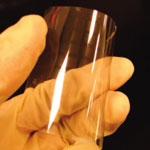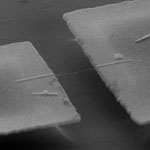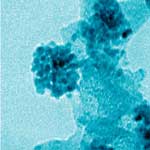Showing Spotlights 177 - 184 of 318 in category All (newest first):
 One of the issues in using carbon nanotubes for applications is the challenge of separating metallic from semiconducting single-walled carbon nanotubes (SWCNT) after production. Developing a rapid and parallel technique for the electronic characterization of high-density arrays of SWCNT devices is essential for future large-scale production processes of nanoelectronics components. Currently used methods for electronic characterization of SWCNT devices and arrays are time consuming to set up, slow to execute, and not suitable for large-scale deployment. These methods include direct electron transport measurements and scanning probe microscopy, which can map the surface potential along a nanotube; again, a very slow technique with limited ability to be integrated into the process flow for microelectronic fabrication and characterization. More recent demonstrations of sorting nanotubes with DNA have been more promising but are very early stage. Researchers in Germany have now presented Voltage-Contrast Scanning Electron Microscopy (VC-SEM) as a new technique for the characterization of molecular electronic devices and device arrays.
One of the issues in using carbon nanotubes for applications is the challenge of separating metallic from semiconducting single-walled carbon nanotubes (SWCNT) after production. Developing a rapid and parallel technique for the electronic characterization of high-density arrays of SWCNT devices is essential for future large-scale production processes of nanoelectronics components. Currently used methods for electronic characterization of SWCNT devices and arrays are time consuming to set up, slow to execute, and not suitable for large-scale deployment. These methods include direct electron transport measurements and scanning probe microscopy, which can map the surface potential along a nanotube; again, a very slow technique with limited ability to be integrated into the process flow for microelectronic fabrication and characterization. More recent demonstrations of sorting nanotubes with DNA have been more promising but are very early stage. Researchers in Germany have now presented Voltage-Contrast Scanning Electron Microscopy (VC-SEM) as a new technique for the characterization of molecular electronic devices and device arrays.
Jan 7th, 2009
 The emerging field of transparent and flexible electronics not only holds the promise of a new class of device components that would be more environmentally benign than current electronics; being able to print transparent circuits on low-cost and flexible plastic substrates also opens up the possibility of a wide range of new applications, ranging from windshield displays and flexible solar cells to clear toys and artificial skins and even sensor implants. Three broad application areas for this technology are taking shape: transparent displays; flexible displays; and transparent/flexible electronics. Traditional materials used for transparent electronics include indium tin oxide films and indium oxide nanowires. In their search for materials that can offer even higher mobility and therefore even better performance, researchers have turned to single-walled carbon nanotubes .New work at the University of Southern California has now demonstrated the great potential of massively aligned single-walled carbon nanotubes for high-performance transparent electronics.
The emerging field of transparent and flexible electronics not only holds the promise of a new class of device components that would be more environmentally benign than current electronics; being able to print transparent circuits on low-cost and flexible plastic substrates also opens up the possibility of a wide range of new applications, ranging from windshield displays and flexible solar cells to clear toys and artificial skins and even sensor implants. Three broad application areas for this technology are taking shape: transparent displays; flexible displays; and transparent/flexible electronics. Traditional materials used for transparent electronics include indium tin oxide films and indium oxide nanowires. In their search for materials that can offer even higher mobility and therefore even better performance, researchers have turned to single-walled carbon nanotubes .New work at the University of Southern California has now demonstrated the great potential of massively aligned single-walled carbon nanotubes for high-performance transparent electronics.
Jan 6th, 2009
 Neural engineering is an emerging discipline that uses engineering techniques to investigate the function and manipulate the behavior of the central or peripheral nervous systems. Neural engineering is highly interdisciplinary and relies on expertise from computational neuroscience, experimental neuroscience, clinical neurology, electrical engineering and signal processing of living neural tissue, and encompasses elements from robotics, computer engineering, neural tissue engineering, materials science, and nanotechnology. In order for neural prostheses to augment or restore damaged or lost functions of the nervous system they need to be able to perform two main functions: stimulate the nervous system and record its activity. To do that, neural engineers have to gain a full understanding of the fundamental mechanisms and subtleties of cell-to-cell signaling via synaptic transmission, and then develop the technologies to replicate these mechanisms with artificial devices and interface them to the neural system at the cellular level. A group of European researchers has now shown that carbon nanotubes may become the ideal material for repairing damaged brain tissue.
Neural engineering is an emerging discipline that uses engineering techniques to investigate the function and manipulate the behavior of the central or peripheral nervous systems. Neural engineering is highly interdisciplinary and relies on expertise from computational neuroscience, experimental neuroscience, clinical neurology, electrical engineering and signal processing of living neural tissue, and encompasses elements from robotics, computer engineering, neural tissue engineering, materials science, and nanotechnology. In order for neural prostheses to augment or restore damaged or lost functions of the nervous system they need to be able to perform two main functions: stimulate the nervous system and record its activity. To do that, neural engineers have to gain a full understanding of the fundamental mechanisms and subtleties of cell-to-cell signaling via synaptic transmission, and then develop the technologies to replicate these mechanisms with artificial devices and interface them to the neural system at the cellular level. A group of European researchers has now shown that carbon nanotubes may become the ideal material for repairing damaged brain tissue.
Dec 29th, 2008
 Researchers have demonstrated that salmon DNA can be used to develop a simple and scalable method for sorting carbon nanotubes that reduces the cost, as compared to commonly used synthetic DNA, by a factor of 1,000. Before carbon nanotubes (CNTs), especially single-walled ones, can live up to the many expectations for their use in nanoelectronics, researchers have to overcome a seemingly trivial but nonetheless major obstacle: how to separate a produced batch of nanotubes according to their properties such as diameter, length, chirality and electronic attributes. Current production methods for CNTs result in a jumble of units with different properties, all lumped together in bundles, and often blended with some amount of amorphous carbon. These mixtures are of little practical use since many advanced applications, especially for nanoelectronics, are sensitively dependent on tube structures and the slightest deviation from a desired set of parameters can lead to vastly different performance results.
Researchers have demonstrated that salmon DNA can be used to develop a simple and scalable method for sorting carbon nanotubes that reduces the cost, as compared to commonly used synthetic DNA, by a factor of 1,000. Before carbon nanotubes (CNTs), especially single-walled ones, can live up to the many expectations for their use in nanoelectronics, researchers have to overcome a seemingly trivial but nonetheless major obstacle: how to separate a produced batch of nanotubes according to their properties such as diameter, length, chirality and electronic attributes. Current production methods for CNTs result in a jumble of units with different properties, all lumped together in bundles, and often blended with some amount of amorphous carbon. These mixtures are of little practical use since many advanced applications, especially for nanoelectronics, are sensitively dependent on tube structures and the slightest deviation from a desired set of parameters can lead to vastly different performance results.
Dec 16th, 2008
 Shrinking device size to nanometer dimensions presents many fascinating opportunities such as manipulating nano objects with nanotools, measuring mass in attogram ranges, sensing forces at femtonewton scales, and inducing gigahertz motion, among other new possibilities waiting to be discovered. The two principal components common to most electromechanical systems irrespective of scale are a mechanical element and transducers. The mechanical element either deflects or vibrates in response to an applied force. Depending on their type, the mechanical elements can be used to sense static or time-varying forces. The transducers in microelectromechanical systems (MEMS) and nanoelectromechanical systems (NEMS) convert mechanical energy into electrical or optical signals and vice versa. A Spanish team has now demonstrated an ultrasensitive carbon nanotube based mass sensor in which they measured chromium atoms with a mass resolution of only 1.4 zeptograms.
Shrinking device size to nanometer dimensions presents many fascinating opportunities such as manipulating nano objects with nanotools, measuring mass in attogram ranges, sensing forces at femtonewton scales, and inducing gigahertz motion, among other new possibilities waiting to be discovered. The two principal components common to most electromechanical systems irrespective of scale are a mechanical element and transducers. The mechanical element either deflects or vibrates in response to an applied force. Depending on their type, the mechanical elements can be used to sense static or time-varying forces. The transducers in microelectromechanical systems (MEMS) and nanoelectromechanical systems (NEMS) convert mechanical energy into electrical or optical signals and vice versa. A Spanish team has now demonstrated an ultrasensitive carbon nanotube based mass sensor in which they measured chromium atoms with a mass resolution of only 1.4 zeptograms.
Nov 18th, 2008
 Adding yet another twist to the emerging debate about the potential risks of nanomaterials, researchers have demonstrated how difficult it is to map out the health effects of nanoparticles. They have shown that, even if a certain nanoparticle does not appear toxic by itself, the interaction between this nanoparticle and other common compounds in the human body may cause serious problems to cell functions. On one hand, this effect could be used to great advantage in nanomedicine for killing cancer cells. On the other hand, unfortunately, it is unknown at present whether the same effect could be observed with healthy cells as well. Since the number of possible combinations of nanoparticles and various biomolecules is immense, it is practically impossible to research them systematically. This latest example of the risk-benefit dichotomy of nanotechnology just shows how thin the line is between promising applications such as effective cancer killers and the unknown risks posed by unintentional effects of exactly the same applications.
Adding yet another twist to the emerging debate about the potential risks of nanomaterials, researchers have demonstrated how difficult it is to map out the health effects of nanoparticles. They have shown that, even if a certain nanoparticle does not appear toxic by itself, the interaction between this nanoparticle and other common compounds in the human body may cause serious problems to cell functions. On one hand, this effect could be used to great advantage in nanomedicine for killing cancer cells. On the other hand, unfortunately, it is unknown at present whether the same effect could be observed with healthy cells as well. Since the number of possible combinations of nanoparticles and various biomolecules is immense, it is practically impossible to research them systematically. This latest example of the risk-benefit dichotomy of nanotechnology just shows how thin the line is between promising applications such as effective cancer killers and the unknown risks posed by unintentional effects of exactly the same applications.
Nov 17th, 2008
 If current research is an indicator, wearable electronics will go far beyond just very small electronic devices or wearable, flexible computers. Not only will these devices be embedded in textile substrates but an electronics device or system could ultimately become the fabric itself. Electronic textiles (e-textiles) will allow the design and production of a new generation of garments with distributed sensors and electronic functions. Such e-textiles will have the revolutionary ability to sense, act, store, emit, and move - think biomedical monitoring functions or new man-machine interfaces - while ideally leveraging an existing low-cost textile manufacturing infrastructure. A recent research report proposes to make conductive, carbon nanotube-modified cotton yarn. This would offer a uniquely simple yet remarkably functional solution for smart textiles - close in feel and handling to normal fabric - yet with many parameters exceeding existing solutions.
If current research is an indicator, wearable electronics will go far beyond just very small electronic devices or wearable, flexible computers. Not only will these devices be embedded in textile substrates but an electronics device or system could ultimately become the fabric itself. Electronic textiles (e-textiles) will allow the design and production of a new generation of garments with distributed sensors and electronic functions. Such e-textiles will have the revolutionary ability to sense, act, store, emit, and move - think biomedical monitoring functions or new man-machine interfaces - while ideally leveraging an existing low-cost textile manufacturing infrastructure. A recent research report proposes to make conductive, carbon nanotube-modified cotton yarn. This would offer a uniquely simple yet remarkably functional solution for smart textiles - close in feel and handling to normal fabric - yet with many parameters exceeding existing solutions.
Nov 14th, 2008
 As we have show before, nanotechnology applications could provide decisive technological breakthroughs in the energy sector and have a considerable impact on creating the sustainable energy supply that is required to make the transition from fossil fuels. Although we love to write about all the clean and green applications that will be nanotechnology enabled, the harsh reality is that dirty energy is still fuelling our way of life. No matter if you are a member of the "drill, baby, drill" crowd or if you are actively involved in saving energy and think that the development of renewable energies can't come fast enough, we have to live with the fact that the world's energy production will continue to depend on oil, gas and coal for quite a few more years. But even here, nanotechnology applications might offer some improvements. A new report shows that nanotechnology, in the form of carbon nanotube rubber composites, could help to significantly enhance oil production efficiency by allowing to probe and drill deeper wells.
As we have show before, nanotechnology applications could provide decisive technological breakthroughs in the energy sector and have a considerable impact on creating the sustainable energy supply that is required to make the transition from fossil fuels. Although we love to write about all the clean and green applications that will be nanotechnology enabled, the harsh reality is that dirty energy is still fuelling our way of life. No matter if you are a member of the "drill, baby, drill" crowd or if you are actively involved in saving energy and think that the development of renewable energies can't come fast enough, we have to live with the fact that the world's energy production will continue to depend on oil, gas and coal for quite a few more years. But even here, nanotechnology applications might offer some improvements. A new report shows that nanotechnology, in the form of carbon nanotube rubber composites, could help to significantly enhance oil production efficiency by allowing to probe and drill deeper wells.
Nov 11th, 2008
 One of the issues in using carbon nanotubes for applications is the challenge of separating metallic from semiconducting single-walled carbon nanotubes (SWCNT) after production. Developing a rapid and parallel technique for the electronic characterization of high-density arrays of SWCNT devices is essential for future large-scale production processes of nanoelectronics components. Currently used methods for electronic characterization of SWCNT devices and arrays are time consuming to set up, slow to execute, and not suitable for large-scale deployment. These methods include direct electron transport measurements and scanning probe microscopy, which can map the surface potential along a nanotube; again, a very slow technique with limited ability to be integrated into the process flow for microelectronic fabrication and characterization. More recent demonstrations of sorting nanotubes with DNA have been more promising but are very early stage. Researchers in Germany have now presented Voltage-Contrast Scanning Electron Microscopy (VC-SEM) as a new technique for the characterization of molecular electronic devices and device arrays.
One of the issues in using carbon nanotubes for applications is the challenge of separating metallic from semiconducting single-walled carbon nanotubes (SWCNT) after production. Developing a rapid and parallel technique for the electronic characterization of high-density arrays of SWCNT devices is essential for future large-scale production processes of nanoelectronics components. Currently used methods for electronic characterization of SWCNT devices and arrays are time consuming to set up, slow to execute, and not suitable for large-scale deployment. These methods include direct electron transport measurements and scanning probe microscopy, which can map the surface potential along a nanotube; again, a very slow technique with limited ability to be integrated into the process flow for microelectronic fabrication and characterization. More recent demonstrations of sorting nanotubes with DNA have been more promising but are very early stage. Researchers in Germany have now presented Voltage-Contrast Scanning Electron Microscopy (VC-SEM) as a new technique for the characterization of molecular electronic devices and device arrays.
 Subscribe to our Nanotechnology Spotlight feed
Subscribe to our Nanotechnology Spotlight feed





